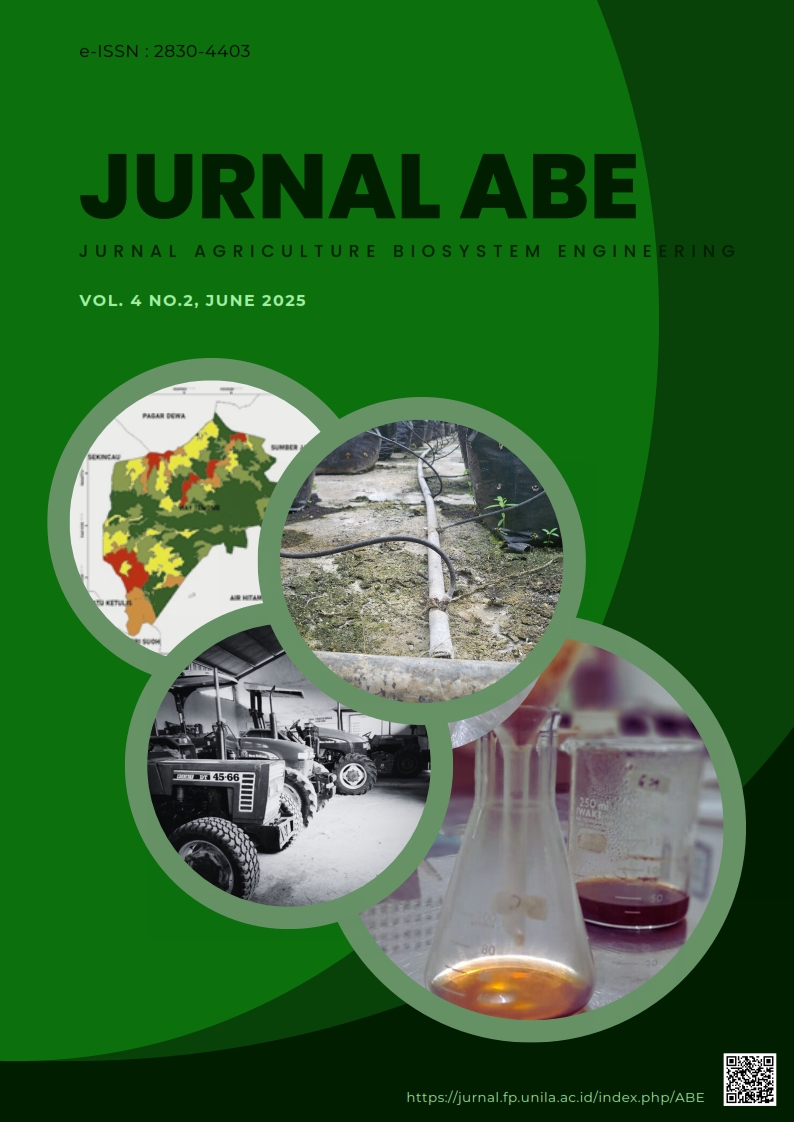Kinerja Pengering dan Karakteristik Penepungan Daun Singkong (Manihot esculenta C)
DOI:
https://doi.org/10.23960/jabe.v4i3.11592 Abstract View: 140
Abstract View: 140
Keywords:
Drying, Hybrid, Proximate test, Cassava leavesAbstract
Cassava is one of the agricultural products that is abundant in Indonesia. The potential for cassava processing is very large along with the development of industry and leaving waste in the form of cassava leaves whose utilization is still limited. Cassava leaves are green vegetables that have nutritional content of protein, vitamins, and minerals. However, cassava leaves have the characteristic of being easily damaged because cassava leaves have a highwater content, allowing enzyme activity to occur. This causes cassava leaves not to be utilized optimally even though cassava leaves have a high protein content. Drying using a convection oven is an effective way to increase shelf life. The use of a hybrid dryer is an effective choice for drying cassava leaves. Material testing using electricity and solar power (hybrid) is carried out for 6 hours. Material testing using an oven is carried out for 4 hours. Testing using direct solar power (traditional) is carried out by drying for 6 hours. Proximate analysis is one method that has often been used to determine the nutritional content of raw materials or food. From the results of testing the proximate content of cassava leaf flour using a hybrid dryer, it was obtained; water content 3.18%, ash content 4.92%, fiber content 13.12%, protein 20.06%, fat content 5.18%, and BETN 66.66%. Drying using an oven, namely, water content 5.96%, ash content 5.99%, fiber content 15.72%, protein 16.132%, fat content 4.35%, and BETN 67.58%. Drying using solar energy (traditional), namely, water content 6.94%, ash content 4.98%, fiber content 16.48%, protein 16.84%, fat content 3.66%, and BETN 67.58%.
Downloads
References
Abubakar, dkk. (2021). Peningkatan Produksi Bahan Pangan Singkong Dengan Memanfaatkan Lahan Gambut Di Gampong Kuala Baro, Kecamatan Kuala Pesisir Kabupaten Nagan Raya. Community Development Journal: Jurnal Pengabdian Masyarakat, 2(3), 829–834.
Adegbola. (1977). Methionine as an additive to cassava based diets. In: Proceedings of a workshop held at the University of Guelph. IDRC and University of Guelph.
Amilia & Choiron. (2017). Studi Kelayakan Usaha Dan Daya Saing Pada Industri Tepung Tapioka Di Kecamatan Pogalan Kabupaten Trenggalek. JSEP (Journal of Social and Agricultural Economics), 10(2), 51.
Andini, dkk. (2023). Pengaruh Suhu dan Waktu Pengeringan Terhadap Karakteristik Serbuk Pewarna Instan Daun Singkong (Manihot utilissima Pohl.). Jurnal Ilmu dan Teknologi Pangan (ITEPA), 12(4), 834.
Ari, dkk. (2023). Pemanfaatan Silase Daun Singkong Untuk Pakan Ternak Sebagai Peningkatan Kualitas Ternak. Eastasouth Journal of Positive Community Services, 1(03), 152–160.
Arifin, S. (2011). Studi Pembuatan Pati Dengan Substitusi Tepung Pisang Kepok (Musa Paradisiaca formatypica) [Skripsi]. Universitas Hasanuddin.
Azizah & Indriani. (2024). Kualitas Fisik Wafer Pakan Berbahan Dasar Rumput Gajah Mini dan Legum Indigofera dengan Komposisi yang Berbeda. Jurnal Ilmu Nutrisi dan Teknologi Pakan, 22(2), 98–102.
Chaiareekitwat, et. al. (2025). Drying Behavior and Effect of Drying Temperatures on Cyanide, Bioactive Compounds, and Quality of Dried Cassava Leaves. Applied Sciences, 15(5), 2680.
Islami, T. (2015). Ubi Kayu. Yogyakarta: Graha Ilmu.
Nainggolan, dkk. (2024). Recent Trends in the Pre-Drying, Drying, and Post-Drying Processes for Cassava Tuber: A Review. Foods, 13(11), 1778.
Rahayuningtyas & Kuala. (2016). Pengaruh Suhu Dan Kelembaban Udara Pada Proses Pengeringan Singkong (Studi Kasus: Pengering Tipe Rak). ETHOS (Jurnal Penelitian dan Pengabdian), 4(1), 99–104.
Sukarman, S. H. (2012). Daun Singkong Adalah Bahan Baku Protein Pakan yang Murah dan Mudah didapat. Balai Pustaka.
Sunarno, M. T. D., Sulhi, M., Samsudin, R., & Hetariana, D. (2011). Teknologi Pakan Ikan Ekonomis dan Efisien Berbasis Bahan Baku Lokal. IPB Press.
Suryadi, T., Darwanto, D. H., & Widodo, S. (2012). Pendugaan Model Permintaan Ubi Kayu d i Indonesia. Prosidding Seminar, 1(2).
Widyasanti, A. (2019). Pengaruh Suhu Pengeringan dan Proses Blansing terhadap Mutu Tepung Daun Singkong (Manihot esculenta C) dengan Metode Oven Konveksi. AGRISAINTIFIKA: Jurnal Ilmu-Ilmu Pertanian, 3(1), 8.
Winangsih, Prihastanti, E., & Parman, S. (2013). Pengaruh Metode Pengeringan Terhadap Kualitas Simplisia Lempuyang Wangi (Zingiber aromaticum L.). Jurnal Buletin Anatomi dan Fisiologi, XXI (1).
Downloads
Published
How to Cite
Issue
Section
License
Copyright (c) 2025 Pingkan Najua Demato, Siti Suharyatun, Tamrin Tamrin, Warji Warji

This work is licensed under a Creative Commons Attribution-NonCommercial-ShareAlike 4.0 International License.
Authors who publish with this journal agree to the following terms:
Authors retain copyright and grant the journal right of first publication with the work simultaneously licensed under a Creative Commons Attribution-ShareAlike 4.0 International Lice that allows others to share the work with an acknowledgement of the work's authorship and initial publication in this journal.
Authors are able to enter into separate, additional contractual arrangements for the non-exclusive distribution of the journal's published version of the work (e.g., post it to an institutional repository or publish it in a book), with an acknowledgement of its initial publication in this journal.
Authors are permitted and encouraged to post their work online (e.g., in institutional repositories or on their website) prior to and during the submission process, as it can lead to productive exchanges, as well as earlier and greater citation of published work (See The Effect of Open Access).
Jurnal Agricultural Biosystem Engineering

JABE is licensed under a Creative Commons Attribution-ShareAlike 4.0 International License.




